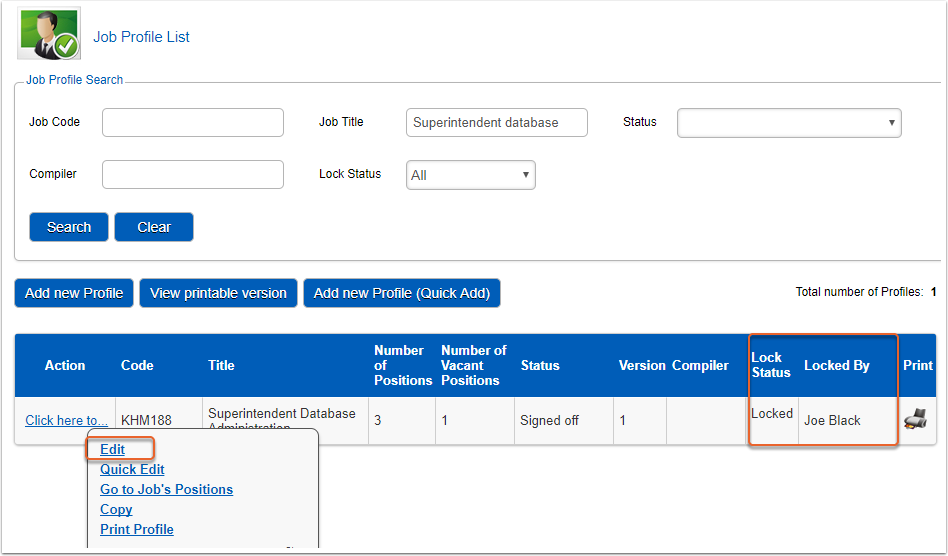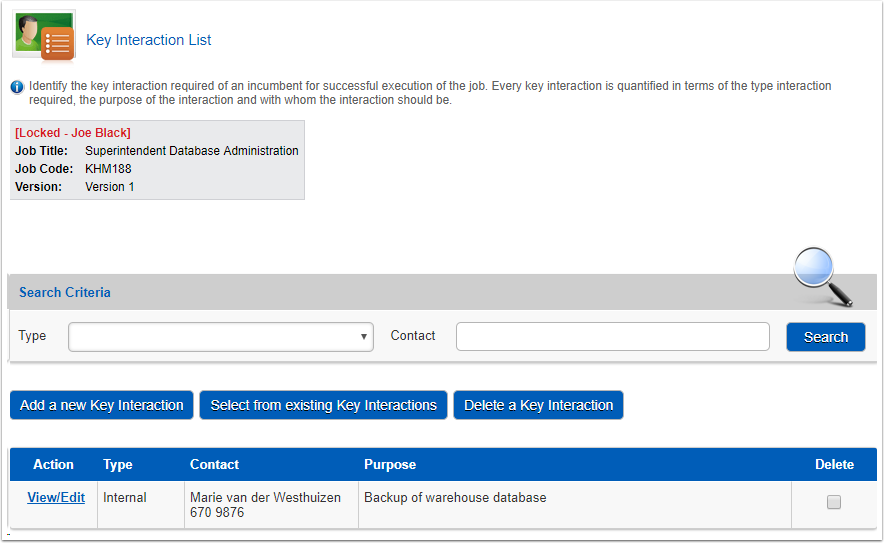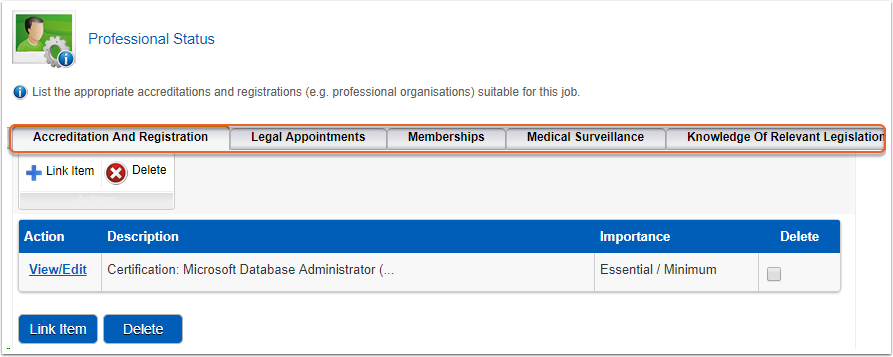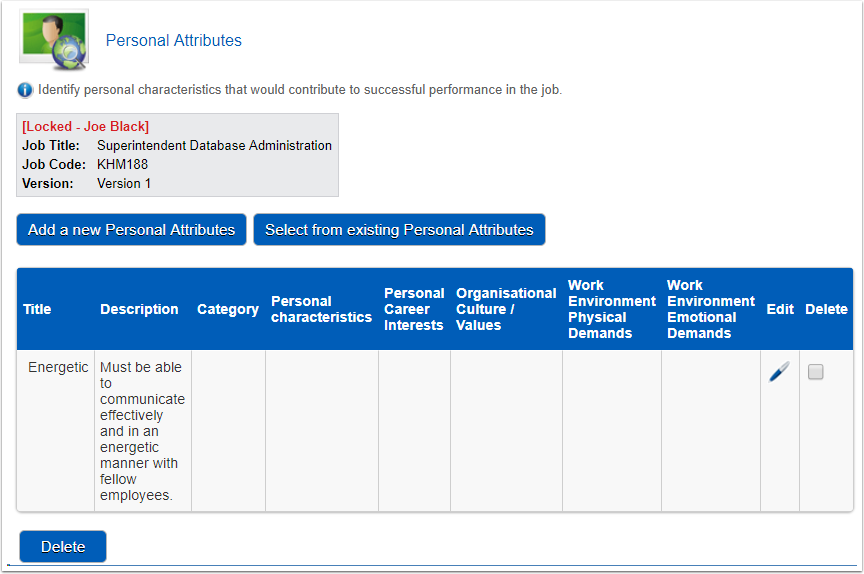Create a new Job Profile
In this section we will create a new profile and then proceed to populate its attributes. Attention will be given only to a few prominent steps and fields. In this article you will learn how to:
- Add a new job profile
- Determine the inheritance rules
- Populate the job profile's attributes
- Work with positions on a job profile
Step 1: Add a Profile
- System Administration | Modules | Job Management | Job Profiler to open the Job Profile List screen.

Job Profile List screen

Select Add new Profile to add a new Job Profile record.
Job Profile Detail Screen

Notes on completing the Profile Detail page
- Fields marked with a * are compulsory.
- Use the hand picker tool to search for standard library values on fields where this icon is displayed.
- Use the back arrow icon to clear a library field’s value.
- On the blank job profile page continue to enter the details of the new profile and select Save when done.
Step 2: Determine the inheritance rules
A very important decision needs to be made at this stage of compiling a job profile and it concerns the inheritance rules that should apply between a job profile and its child positions. In order to explain the concept of inheritance and the different versions thereof as implemented in the Job Profiler module, please review the definitions and illustrations given below.
We will be using the example of ladybugs to illustrate each inheritance option.
Standard inheritance (Child positions inherit the parent job profile's attributes)

This setting is available on every child position record and applies only to the specific child position. The following rules apply to standard inheritance:
- If ticked the child position will be exactly the same as the parent profile.
- No changes to the child position are allowed.
- If this setting is switched on for an EXISTING child position all child-specific information currently in that child position will be overwritten with the parent profile’s information.
Inheritance Plus (Child Positions Inherit the Parent Profile’s Attributes And Additions can be made)

The setting to not only inherit the parent job profile’s information, but also to allow adding information to the position profile, is available on the parent job profile’s page. The following rules apply to the setting controlling inheritance plus:
- If not ticked the child position will be kept exactly the same as the parent profile.
- If ticked the child position will inherit the parent profile’s information and additions to the child position’s information will be allowed.
- Existing information from the parent profile as seen on the child positions cannot be changed or removed.
- If a job profile already has child-specific information added to its child positions and this setting is then switched off, all child-specific information will be deleted in order to make the child positions return to the standard inheritance profile.
No Inheritance (Child Positions Differ Completely From the Parent Job Profile)

To allow a child position’s information to differ substantially from its parent profile, settings are available on every child position’s attribute pages (e.g. Profile Detail, Notes, Documents, Positional Relationships, Access Rights as well as on the sections included in the Output and Requirements Profiles) with which to control this. The following rules apply to the settings controlling inheritance per position attribute:
- If an attribute’s Inherit from Profile setting is not ticked, the child position is allowed to differ completely from the parent profile.
- If ticked the child position will inherit the parent profile’s information and:
- Additions are allowed if the parent profile’s setting Allow adding on positions while inheriting is switched on.
- Additions are NOT allowed if the parent profile’s setting Allow adding on positions while inheriting is switched off.
- If a position already has child-specific information added to it and the setting Inherit from Profile is switched on, all child-specific information on the attribute will be deleted in order to make the attribute of the child position return to the parent profile’s attribute.
Unlock a Profile
When a user is working on a specific profile, the profile is locked and he will be the only person able to edit the job profile.
In some cases it would be necessary for another user to work on a profile not created by himself. Only a System Administrator is authorised to unlock a profile but for completeness’ sake it will also be addressed here.
- Confirm that the position is locked.
- Select to open the specific locked Job Profile by clicking on View or Edit in the Action column.
- In order to unlock this profile, select the Unlock Profile menu item.
- The profile is unlocked and you are redirected back to the Job Profile List page.
- Immediately after the job profile is opened it is locked again, but this time to the new user’s profile.
Step 3: Populate the Job Profile's attributes
In this section examples are given of the different attributes that can be used to describe a job profile. Not all attributes are discussed in detail, but the most important attributes that require information relevant to a job profile in other modules in the system, will be discussed.
Add a Note to the Profile
On the profile’s menu, select Notes to open the screen below. This screen is actually used to manage outstanding tasks or activities on a profile.

On the Job Profile Notes screen select Add a new Note where any comments or notes pertaining to the profile can be recorded. A due date can also be assigned. These tasks are not allocated to a specific person but will lie against the profile.

Enter all the detail on the Note Detail window and select Save.

A report to list all these tasks against a profile is available under the Reports menu section.
Add a document to the Job Profile
Select the Documents menu item to display the Job Profile Document List screen.


Select Add to browse for a document and provide additional information.

Select Save to attach the document to the job profile.
Output Profile: Define the Job Intent
Expand the Output Profile section and select the Job Intent menu item to display the following Job Intent screen.

This screen has got two to four individual sections depending on a client’s configuration. The screen’s intention is to define a job’s:
- Purpose
- Major Challenges a person in such a job would encounter
- Decision limits imposed on an incumbent
- Responsibilities
- Interactions with other role players
Examples of these screens are shown below.
Job Intent - Purpose

Job Intent - Major Challenges

Job Intent - Decision Limits

Job Intent - Responsibilities

Output Profile: Define the Career Path
Select on the Career Path menu item to open a screen where a typical career path for a specific job profile can be mapped.

The following screen is displayed showing up to five future positions for the selected Job Profile.

Output Profile: Define the Job Outputs
Select on the Outputs menu item to open a screen where typical outputs for a job can be defined. When any output record is added or opened, in addition to the actual output description, the following information is also required:
- Typical success indicators to identify the units of measurements that can be used to indicate whether outputs have been delivered successfully. A success indicator is not a standard or target. It is used in a performance contract to develop objectives and set targets.
- Typical outputs standard which are the minimum measurable criteria that outputs must conform to for successful performance.

The list of Outputs screen is displayed below. Click on the Edit icon to add Success Indicators and Output Standards.

The Outputs screen is divided into three sections as follows:
- Outputs Section
- Success Indicators Section
- Output Standards Section



Output Profile: Key Performance Areas - KPA's
In the Output Profile section, select the Key Performance Areas menu item to display a list (if any) of KPA's that apply to the job profile being built.


Output Profile: Define the Relevant Business Processes
Select the Relevant Business Process menu item to open a screen where business processes specifically impacted by the job profile being built are listed.


Output Profile: Key Interactions
Select the Key Interactions menu item to open a screen where key interactions are specified per incumbent to successfully execute his job.

Requirements Profile: Specify the required Qualifications
Expand the Requirements Profile section and select the Qualifications menu item to open a screen where required qualifications for a job profile can be listed.


Select Add a new Qualification to add a new qualification to the library. This is done on the screen below. The qualifications added in this way become part of the library and can be edited and reused.

Requirements Profile: Specify the required Training
Expand the Requirements Profile section and select Training Interventions to open a screen where a list can be drawn up of courses a job's incumbent can be expected to go on or should have been on.


Select Add to add a training intervention to the list.

When adding an intervention to the list, the Training Intervention Detail screen opens in which the intervention can be defined.
- This screen draws its information from two sources - implying that they must have been populated before this section can be completed.
- Training Interventions (Accessible from the system’s Administration or Event Management modules)
- PDP fields (Accessible from the PDP module)
NOTE: The fields in the For reporting purposes only section has been developed for a specific client. The information is displayed in a report that has been developed for and used exclusively by them. The information does not have an influence on any other reports or fields within the system.
Requirements Profile: Specify the required PDP Performance Targets
This section of the Job Profiler module is used to set performance targets for an employee based on the job’s Development Plan.
Expand the Requirements Profile section and select PDP Performance Target to open the screen shown below.


Select "Add" to add a performance target to the list.
When a performance target is added, the following details screen is used to select the values and targets:

Select Save to complete the performance target details or Save add New to save the current performance target and add another performance target.
Requirements Profile: Specify the required Professional Statuses
Select the Professional Status menu item to open the screen shown below.

Lists the appropriate information suitable for a particular job. The following sections are available:
- Accreditation And Registration
- Legal Appointments
- Memberships
- Medical Surveillance
- Knowledge Of Relevant Legislation
Requirements Profile: Specify the required Experience
Expand the Requirements Profile section and select the Experience menu item to open a screen where an indication can be given of the number of years that a successful applicant/incumbent should have functioned in a specific functional area, business process and/or place in a specific capacity.


Requirements Profile: Specify the required Skill
Expand the Requirements Profile section and select the Skills menu item to open a screen where a list of skills can be drawn up that a successful applicant/incumbent should have.



Requirements Profile: Specify the required Competencies
Expand the Requirements Profile section and select the Competencies menu item to open a list of competencies expected in the successful applicant/incumbent.



Competency is the ability of an individual to perform a job properly.
When adding or editing a competency, the following screen will appear:


Requirements Profile: Specify the required Knowledge and Skills
Expand the Requirements Profile section and select the Knowledge and Skills menu item to open a screen where, for the successful applicant/incumbent, less formal types of skills and qualifications can be listed.



Requirements Profile: Specify the Personal Attributes
Expand the Requirements Profile section and select the Personal Attributes menu item to open the screen shown below.

This screen lists all the desirable qualities and personal attributes one would like to see in the successful applicant/incumbent.
Requirements Profile: Specify the Driving License
Expand the Requirements Profile section and select the Driving License menu item to open the screen shown below


Requirements Profile: Specify the Programmes
Expand the Requirements Profile section and select the Programmes menu item to open the screen shown below.


Requirements Profile: Specify the Unit Standards
Expand the Requirements Profile section and select the Unit Standards menu item to open the screen shown below.


Requirements Profile: Specify the Licenses
Expand the Requirements Profile section and select the Licenses menu item to open the screen shown below.


Step 4: How to work with Positions on a Job Profile
The Positions section is addressed separate from the other job profile attributes for the following reasons:
- A job profile can have multiple positions linked to it.
- A position has exactly the same set of characteristics as the parent profile.
- A position can inherit its parent profile’s attributes.
- When a position is opened for editing, the Job Profile module’s look and feel stays exactly the same on all screens as for the profile BUT it now functions on a position level.
Positions as a special attribute of a Profile
It is important to understand how the system handles positions. A position is linked to a profile but it is also handled as a special case of a profile in that the same attributes of the profile are also available to the position as can be seen from the following diagram.

For example, the job profile can have notes recorded against it. When one of the job profile’s positions is opened, that position can also have notes recorded against it. (It can either inherit the profile’s notes or it can have its own set of notes.)
Here follows an example of a position created for a job profile. We will repeat all the steps to get from the profile to the position.
- Select PROFILE SEARCH to open the Job Profile List screen.
- Select the applicable job profile from the list.

From the Job Profile menu, select Positions to open the list of positions linked to this profile.


Inheriting the attributes of the Profile to the Position
The position that we are working on automatically has all the attribute SECTIONS that the profile had but it does not automatically inherit the information contained IN the profile’s sections.
Near the top of the Profile Detail screen is a check box which must be specifically ticked for EVERY position that is supposed to inherit the attributes of its parent profile. More on this can be found in the section Child Positions Inherit the Parent Profile’s Attributes.

This position will now inherit the parent profile’s attributes. If any one of the attribute sections of a position is opened, the following can be seen:
- The tick in the check box at the top of the page indicates that on this particular position the attributes are inherited from the parent job profile.
- The example below shows that all the Outputs attributes were inherited from the parent's profile, and there is space for position-specific outputs to be loaded as well.

The attributes of a Position
Under the Job Profile menu, the user can set the following attributes of the position taking into consideration the rules referred to in the section Child Positions Inherit the Parent Profile’s Attributes

Manage a Position
Three main actions are possible on the Job Profile Positions List screen:
- Select Add a new Position to open a blank position screen for adding a new position.
- Select View printable version to open a printer-friendly version of the position list page.
- Select the Click here to... hyperlink to display the following options:
- Edit
- Copy
- Move
- Print Template

Edit a Position
Select Edit and note the following changes:
Copy a Position
An existing position can be used as template for more positions to be added to the job (e.g. if there are 10 positions for the job which all have the same basic details).
- Choose the position to be used as 'template'.
- In the position’s Action field, select Click Here To.... | Copy.
- Ensure the position code and title for the new position to be created is specified correctly.
- If the same position is to be copied multiple times, click Copy Position Again for each.
- For the last position to be copied, click Copy Position.
- The Organisation Structure link is NOT duplicated this has to be done separately for each new position copied

Move a Position
An existing position can be copied to another existing job Profile.
- Choose the position to be moved.
- In the position’s Action field, select Click Here To.... | Move.
- Select the New Job Profile by clicking on the hand picker.
- Select Validate

The Move Job Position screen is divided into 4 sections:
- Heading and selection
- Validation info - all information that will be deleted, added or applied when the move process is complete.
- Last Position - you can delete the position profile if it the last position on the Job Profile.
- Additional information - summarises all the rules when a position is moved.
Select that you agree with the changes and Continue.




Print a Template
Select Export to generate a Job Position Profile report as shown in the example below.

Job Position Profile Report











